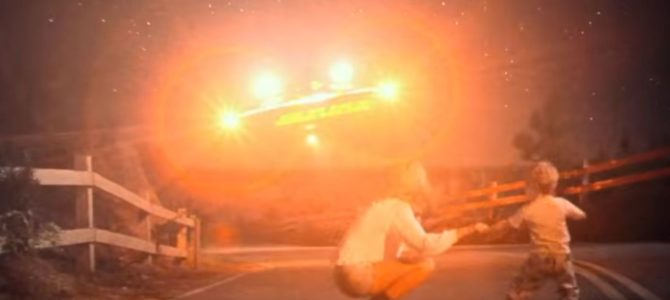
The only exciting thing in theaters last weekend was the re-release of “Close Encounters of the Third Kind,” coming up on its 40th anniversary. This was Steven Spielberg’s first big-budget movie, with all the headaches and powers that a Hollywood studio brings. He got the chance to develop his ideas on the grandest scale, for about $20 million.
Columbia—a real studio back then, but teetering—made eight times that in the domestic market and the same again internationally. Spielberg got the famous French director Francois Truffaut to act in his movie and the man saw what ingenuity and hard work goes into making the spectacular things Hollywood had to offer.
This is when Spielberg switched from his early career, which was heavy on horror and terror, to the genial magician America has come to know and love. How did he earn this success? He concocted his generation’s version of all-American: a mix of amazement, thrills, laughs, and sentimentality. It seems so recognizable nowadays, but it’s still almost impossible to replicate.
Spielberg is unique among successful directors because he understands there is something uncanny in the phrase “family adventure” although it’s nevertheless what Americans long for. He has satisfied that longing for the last four decades like no one else, and “Close Encounters” was the moment he stumbled onto the formula that would become his destiny.
Two Radically Different Themes Together
From the vantage point of 2017, the movie is emphatic about two things that radically diverge. First, America: Spielberg displayed a family coming apart in the unbearable intimacy of their suburban home, in an annoying neighborhood that’s too close to bear, but too far away to help. He also portrayed the entire country undergoing a social-psychological crisis.
There’s remarkable subtlety in the way he uses typical Hollywood editing for atypical purposes: to allow the audience to suffer along with the family and to be as bewildered and amazed as the society, missing, at least on a first viewing, the disturbing evidence of a mounting social crisis. You can think of him as a good reporter or even prophetic about American society and individualism, but he’s not heavy-handed. He turns the sentimentality of the family home into heartbreak without becoming cloying or preachy.
The other major plot point doesn’t seem to belong in suburban America: a strange hope that something wonderful is waiting out there in the universe, tied up with aliens. This is nowadays almost impossible to imagine. It takes Spielberg to make aliens appealing and a source of hope. The rest of Hollywood treated the matter almost exclusively in the mood of horror, and still does.
So this alien hope as a solution to social trouble was always going to be tricky, because both aspects speak to the exhaustion of American society and socially aware cinema in the 1970s. But wasn’t this a necessary reaction? Didn’t the cinema that aimed to appall America cause this new development, the blockbuster, which Spielberg pioneered?
The Advent of the Space Western
The escape into space, the emergence of sci-fi as the new background for American adventure, is not just social exhaustion. It’s also a form of liberation. Space replaced the Wild West and aliens the Indians. This is what Spielberg learned from his idol, John Ford, and it’s why he kept watching Ford’s epic movie, “The Searchers,” while making “Close Encounters.”
This also explains the transformation of science fiction. Spielberg, as close to a poet of the Boomers as anyone came, was the first to figure out that sci-fi would not look or feel like the ‘50s. Manly adventure and scientific power were out. The human quest for meaning was in. The previous form was too harsh and too much bent on conquest. Spielberg knew America was longing instead for discovery and ultimately for a friend. So he doesn’t give you a story of colonizing Mars or waging war there, but of aliens coming to earth.
Of course, a new kind of adventure needs a new kind of hero. Enter Roy Neary (played by Richard Dreyfuss), a family man driving a truck for a power company. His cluttered house bespeaks his fascination with things beyond his reach, as well as his sense that society and family are crowding him out. Devoted fans have noted that lots of the toys and clutter announce plot developments and important scenes later in the movie. This kind of ironic prophecy is meant to suggest an invisible but real connection between the original domestic setting and the utterly alien adventure that follows.
There’s no doubt the Neary parents and their three kids love each other. But the evidence is mostly the bitter intensity of their fighting. One solution would be for the kids to reproduce their father’s sense of wonder. But they want some silly entertainment instead of going to see “Pinocchio” with him. The man is an artist at heart, and his wife resents it so much that she stands up for the kids’ freedom without understanding this would liberate the father from attachment to them. Anyway, he finds suburbia almost unbearable. He never has a good moment with his neighbors.
Spielberg, however, turns almost cruel with this family. One particular scene of love turning to hysteria starts in the bedroom, with Roy’s wife trying to unlock the bathroom door because she fears for his life—he’s been depressive, erratic. Her fear is a way of reaching out to him, to care for him, and speaks of love.
But then it turns around to her locking herself in the bathroom instead, after he desperately asks her to embrace him. Meanwhile, their children shriek, abandoned while the parents fight. One calls Roy a crybaby. The heartrending family crisis in that bedroom is choreographed as a comic reversal. It’s almost cynical, not something Spielberg is reputed for.
‘Close Encounter’s’ Fantasies of Abandonment
This prepares Roy’s abandonment of his family to chase his fantasy of aliens visiting earth. There’s no living with them, so of course he’s looking for a substitute. In a still stranger moment, he kisses another woman, who is also chasing the aliens. She’s a single mother trying to save her alien-abducted child. He’s excited the aliens have finally arrived. He abandons her, too—that’s how self-involved he is.
The aliens eventually bring back people they’ve abducted who wish to return to mankind, a fantasy of healing wounds and making love whole again. Roy, however, is trying to leave it all behind. Spielberg may not have realized just how far he was pushing individualism of the “follow your dreams” variety, but the story he tells does speak to certain fantasies of abandonment.
It turns out the child was right to call his father crybaby—infantile fantasies dominate his adult life. Now, some parts of being a child are not bad. There is one moment where Roy behaves like a director: his son wants to learn fractions, but is refusing to think about abstract numbers. Roy ingeniously makes it all come alive for the boy: he uses toy trains on track for collision to get an answer. This, tellingly, fails. The boy is too willful, as a rejection of his father. But it’s a marvelous idea: it’s a practical problem with a solution, like in the movies!
Then, too, the psychology is spot on: the threat of imminent collision plays out the adult’s impatience with a child. This sets up Roy’s own problem with incomprehension—treating the world as entirely new, as a child does, is incredibly painful for an adult, and might turn to insanity. But that’s necessary to start a new life, even without choosing to abandon one’s family.
Uncovering Our Deep Restlessness
The great French director Jean Renoir wrote about this movie to his friend Truffaut. He found Spielberg’s metamorphosis of science into poetry enchanting. He called him a town fool: a man touched by fairies. I’ve already noted the story’s irresponsibility about man’s relational nature. Within the movie, as in reality, the aliens are sensational at a merely individualistic level—lots of people throw away their lives to go chase after them. Whoever’s left behind is forgotten.
Everyone is haunted by some longing, and the haunted are unable to associate even among themselves. Nevertheless, the experience of wonder is in some sense deeply personal and almost impossible to communicate.
Now, if we leave the aliens aside for a moment—if we leave the plot and look at the symbol—it becomes obvious that all these Americans are desperately looking to transcend their sorry lives. Being American is just not good enough. There’s gotta be more to life than normality, because being normal is just not true to our feared mortality.
These characters who all experience alien encounters are weirdoes, but they’re recognizably Christian and American in their restlessness. The need to find out what happened to the lost is exactly like asking about an afterlife. Spielberg doesn’t quite manage to give a sense of man’s dignity by telling this story of meeting aliens, of reaching out to something beyond our self-involvement, but he comes closer than most, and does a much better job here than in “E.T.”
The aliens turn out to be children, too, as though to make us ask ourselves: who else would go exploring? This shows you that Spielberg is trying hard to tell Americans what he thought they really wanted to hear, that the universe is not blindly indifferent or out to kill them. He tried to find a form of providence for desperate people. He knew that the need to believe in the goodness of man was then turning to some exterior witness or authority even—to see that goodness confirmed by the interest of aliens. If Americans should stop believing in God, that’s the alternative—belief in the cosmos.
‘Close Encounters’ Without the Abandonment
It’s worth remembering that the previous generation had a great optimism about talking to animals and aliens. The sub- and super-human were thought approachable in a way that would prove people are not alone without God, and intelligence exists somewhere else. Lots of people, especially scientists, popularized these things as a form, ultimately, of self-help. This is not really a good thing, but it does highlight a strange form of the desire to relate to another intelligent being for people who find it hard to do that with actual people.
The movie tries to feed that need for aliens while retaining humanity. It’s what Carl Sagan tried, the famous scientist who both popularized physics with his fabled “Cosmos” show and wrote the novel “Contact” about meeting aliens. But Spielberg is a real poet, so it’s a much better story. He offers realistic human beings to care about and a recognizable America to look at.
The great writer Walker Percy explained all this in his book “Lost in the Cosmos,” indispensable reading about the connection between abandoning America and trying to escape into nature. Percy would say Spielberg showed the problem in a dramatic form, without lies or deceptions. He didn’t offer solutions, but he made it obvious to everyone with eyes to see that America is at some level in trouble.
Hopefully, another Spielberg will read Percy and use his wisdom to give the audience something like “Close Encounters,” but without the abandonment, which Spielberg has often confessed was a big mistake. Meanwhile, we have this remarkable work of social anxiety and genuine wonderment at the universe. That’s our situation today seen in its best light, and no one today is even half-trying to live up to Spielberg’s legacy. So watch this movie and tout it—maybe someone will take a hint!









